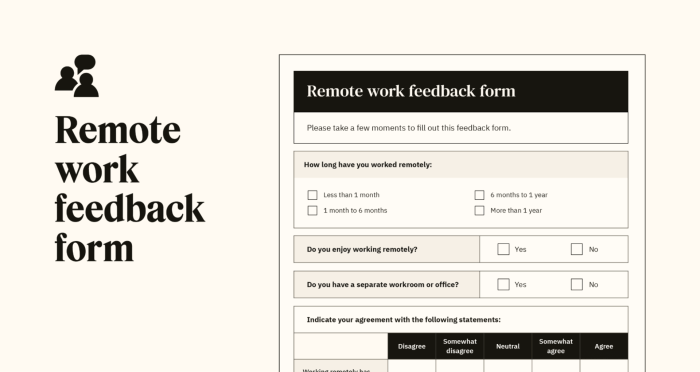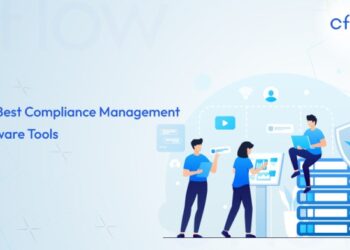Exploring the realm of customizable remote work feedback tools opens up a world of possibilities for enhancing communication and productivity in a virtual workspace. As organizations navigate the new normal of remote work, the need for tailored feedback tools that cater to diverse needs becomes increasingly paramount.
Let's delve into the key aspects of customizable remote work feedback tools and how they can revolutionize the way feedback is gathered and utilized in a remote setting.
Customizable Features
Customizable features in remote work feedback tools play a crucial role in tailoring the tool to meet the specific needs of different organizations. These features allow users to personalize their experience, enhance usability, and gather relevant insights to improve remote work processes.
Performance Metrics Customization
- Organizations can customize performance metrics based on their unique goals and objectives.
- This customization enables teams to focus on key performance indicators that matter most to their success.
- For example, a sales team may prioritize metrics related to customer acquisition, while a customer service team may focus on resolution times.
Feedback Forms Customization
- Customizable feedback forms allow organizations to collect specific feedback tailored to their needs.
- This customization ensures that the feedback received is relevant and actionable for continuous improvement.
- For instance, a software development team may customize feedback forms to gather insights on code quality and collaboration.
Reporting Dashboard Customization
- Users can customize reporting dashboards to display metrics and data that are most important to them.
- This feature provides a clear overview of performance and progress towards goals.
- For example, managers can customize dashboards to track team productivity, engagement levels, and performance trends.
Integration with Existing Systems
Seamless integration with existing tools and platforms is crucial for the effectiveness of remote work feedback tools. It allows for a more streamlined workflow and ensures that all data is consolidated in one place for easy access and analysis.
Remote work feedback tools that can easily integrate with other software offer numerous benefits to organizations. They enable employees to provide feedback within the familiar systems they already use, increasing user adoption and engagement. Additionally, integration allows for automated data transfer, reducing the risk of errors and saving time for both employees and administrators.
Successful Integrations and Workflow Efficiency
- One example of successful integration is the seamless connection between a remote work feedback tool and project management software. This integration allows feedback to be directly linked to specific projects or tasks, providing context and actionable insights for improvement.
- Another impactful integration is the synchronization between a remote work feedback tool and HR systems. This integration enables performance evaluations to be more data-driven and comprehensive, leading to better employee development and organizational growth.
- Integrating a remote work feedback tool with communication platforms like Slack or Microsoft Teams enhances collaboration and feedback sharing among team members. This real-time feedback exchange fosters a culture of continuous improvement and innovation within the organization.
Data Security and Privacy
When it comes to remote work feedback tools, data security and privacy are of utmost importance. Ensuring that sensitive information is protected and handled with care is crucial in maintaining trust and compliance with regulations.
Importance of Robust Data Security Measures
- Implementing encryption protocols to secure data transmission.
- Regularly updating security measures to stay ahead of potential threats.
- Restricting access to sensitive data to authorized personnel only.
- Conducting periodic security audits to identify vulnerabilities and address them promptly.
Best Practices for Ensuring Data Privacy
- Obtaining explicit consent from employees before collecting any personal data.
- Anonymizing feedback data to remove any identifying information.
- Storing data in secure servers with restricted access.
- Complying with data protection regulations such as GDPR or HIPAA.
Different Approaches to Maintaining Data Security
- Cloud-based solutions with built-in security features.
- On-premise solutions for companies with strict data security policies.
- Implementing multi-factor authentication for added protection.
- Regularly training employees on data security best practices.
User Experience Design

User Experience Design plays a crucial role in creating effective remote work feedback tools. It involves designing interfaces that are intuitive, easy to navigate, and visually appealing to enhance usability and overall user satisfaction. By focusing on the needs and preferences of remote workers, feedback tools can be tailored to provide a seamless and engaging experience.
Tips for Designing User-Friendly Interfaces
- Keep the interface simple and clutter-free to avoid overwhelming users.
- Use clear and concise language to guide users through the feedback process.
- Incorporate visual elements such as icons and color coding to enhance navigation and understanding.
- Ensure responsiveness across different devices to accommodate various work setups.
Examples of Well-Designed Feedback Tools
- Pulse Surveys:Short and targeted surveys that are easy to complete, providing quick feedback for remote workers.
- Continuous Feedback Platforms:Real-time feedback tools that allow for ongoing communication and collaboration between remote teams.
- Feedback Dashboards:Interactive dashboards that visualize feedback data in a meaningful way, promoting user engagement and data-driven decision-making.
Closing Notes

In conclusion, customizable remote work feedback tools offer a dynamic solution to the evolving landscape of remote work environments. By prioritizing customization, seamless integration, data security, and user experience design, organizations can empower their teams to thrive in a virtual workspace.
Embracing these tools not only fosters better communication but also cultivates a culture of continuous improvement and growth.
User Queries
How important are customizable features in remote work feedback tools?
Customizable features play a crucial role in meeting diverse organizational needs and enhancing user experience by tailoring feedback tools to specific requirements.
What is the significance of integrating remote work feedback tools with existing systems?
Seamless integration with other tools and platforms ensures efficiency in workflow and maximizes the benefits of remote work feedback tools.
How can data security be ensured in customizable remote work feedback tools?
Robust data security measures are essential for maintaining privacy while collecting feedback remotely, and different approaches can be compared to find the most effective solution.
What role does user experience design play in remote work feedback tools?
User experience design is critical for creating effective feedback tools that are user-friendly and enhance usability, ultimately driving user engagement.






![What is IT Project Management? [2023] • Asana](https://business.mardinata.com/wp-content/uploads/2025/10/project-management-industries-120x86.jpg)




